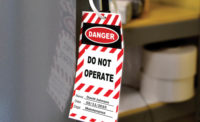 “Pinch points” are present in most mechanical devices that, in its operation, might pose a risk of injury to body parts.
“Pinch points” are present in most mechanical devices that, in its operation, might pose a risk of injury to body parts.
A pinch point is defined as any point where it is possible for a body part to be caught between moving and stationary portions of equipment. If a worker or any parts of the worker’s body occupies that space during the pinching movement, there is a high probability of injuries such as fractures, amputations, or even death.
Recently, an employee sustained a finger injury due to a sudden movement of equipment he was working with, trapping his hand against stationary equipment. After investigation, it was discovered that the injury could have been prevented had the proper equipment been used.
In order to prevent accidents involving pinch points the following must be instilled into our everyday’s job:
- Use the right tool for the job
- Identify possible pinch point hazards in your work area
- Concentrate on objects that move or capable of moving. Ask yourself, “What will happen if this moves? Will I be in the path of that movement?”
- Be aware of pinch points created by objects that move and come into direct or close contact with relatively fixed objects (e.g., equipment placed close to pipeline or concrete, container docks, or suspended loads near fixed or mobile equipment). Ask yourself, “If this load moves or shifts unexpectedly, will I be in the way?”
- Be on guard whenever you put your hands, fingers, toes, or feet “between” anything.
- Discuss and point out pinch point hazards as part of your risk assessment and toolbox meetings
- Make sure your hands are placed where you can see them
- Never operate equipment or machinery without the required machine guards. Guards are designed to prevent contact with pinch points and points of operation.
- Never place yourself or any part of your body in a potential pinch point area unless protective measures are provided for such activity. When reaching in to operate a control or reaching for an object, consider where your body parts are located. If it is within a pinch point, identify an alternative position or make sure all movable parts are fixed in place.
- Identify possible pinch point hazards in your work area
SOURCE: Occupational Safety, Health and Environment http://safetygalleria.com








